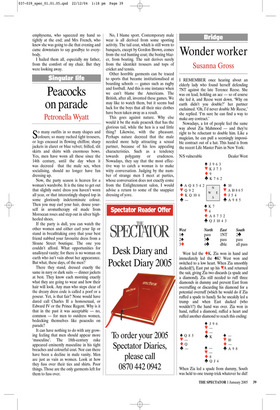Peacocks on parade
Petronella Wyatt
So many outfits in so many shapes and colours; so many ruched tight trousers, or legs encased in flowing chiffon; sharp jackets in claret or blue velvet; frilled, slit skirts and shirts with enormous bows. Yes, men have worn all these since the 14th century, until the day when it was decreed that the male sex, when socialising, should no longer have fun dressing up.
Now, the party season is heaven for a woman’s wardrobe. It is the time to get out that slightly outré dress you haven’t worn all year, or that interestingly shaped top in some gloriously indeterminate colour. Then you may curl your hair, douse yourself in aromatherapy oil made from Moroccan roses and step out in silver highheeled shoes.
If the party is dull, you can watch the other women and either curl your lip or stand in breathtaking envy that your best friend nabbed your favourite dress from a Sloane Street boutique. The one you couldn’t afford. What opportunities for unalloyed vanity; for there is no woman on earth who isn’t vain about her appearance. But what, these days, of the men?
There they stand, dressed exactly the same in navy or dark suits — dinner jackets at best. They know each morning exactly what they are going to wear and how their hair will look. Any man who steps clear of the dreary dress code is called a poof or a poseur. Yet, is that fair? None would have dared call Charles II a homosexual, or Edward IV or the Prince Regent. Why is it that in the past it was acceptable — no, common — for men to outdress women, bedecking themselves like peacocks on parade?
It can have nothing to do with any growing feeling that men should appear more ‘masculine’. The 18th-century rake appeared eminently masculine in his tight breaches and colourful coat. Nor can there have been a decline in male vanity. Men are just as vain as women. Look at how they fuss over their ties and shirts. Poor things. Those are the only garments left for them to fuss over. No, I blame sport. Contemporary male wear is all derived from some sporting activity. The tail coat, which is still worn to banquets, except by Gordon Brown, comes from the red hunting coat; the boring blazer, from boating. The suit derives surely from the identikit trousers and tops of cricket and tennis.
Other horrible garments can be traced to sports that became institutionalised at boarding schools — games such as rugby and football. And this is one instance when we can’t blame the Americans. The British, after all, invented these games. We may like to watch them, but it seems bad luck for the boys that all their nice clothes have been taken away as a result.
This goes against nature. Why else would it be the male peacock that has the glorious tail, while the hen is a sad little thing? Likewise, with the pheasant. Perhaps nature decreed that the male needed more help attracting a sexual partner, because of his less appealing characteristics. Such as a tendency towards polygamy or crudeness. Nowadays, they say that the most effective way to catch a woman is to make witty conversation. Judging by the number of strange men I meet at parties, whose conversation does not exactly come from the Enlightenment salon, I would advise a return to some of the snappier dressing of yore.







































 Previous page
Previous page